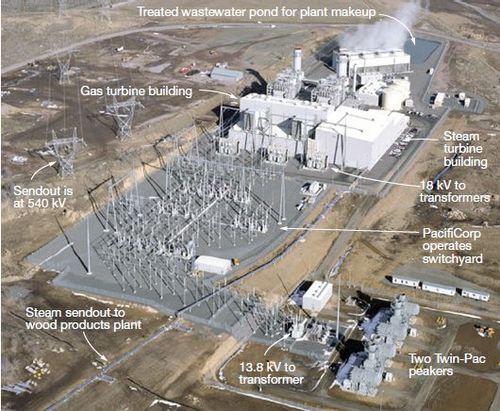Co-generation in Oregon: Difference between revisions
Vortexrealm (talk | contribs) (Not necessailry depending upon heat recovery mechanism) |
Vortexrealm (talk | contribs) (added references) |
||
| Line 3: | Line 3: | ||
[http://en.wikipedia.org/wiki/Cogeneration Cogeneration power stations | [http://en.wikipedia.org/wiki/Cogeneration Cogeneration] or combined heat and power (CHP) stations can simultaneously generate both electricity and useful heat (through steam or hot water)<ref>[http://www.clarke-energy.com/chp-cogeneration/ Cogeneration]</ref>. Cogeneration plants produce both electricity and useful heat from one fuel source, which may be natural gas, wood or coal. Excess process steam from a cogeneration plant can go to lumber mills, for example. [http://nwrenewablenews.wordpress.com/2009/01/27/oregons-seneca-sawmill-to-begin-construction-of-wood-fired-cogeneration-plant/ Oregon is a hotbed for development of cogeneration and other biomass technologies] that involve turning trees, brush, straw and other organic materials into electricity. [http://www.renewableenergyworld.com/rea/news/article/2010/11/biomass-co-generation-facility-breaks-ground-in-oregon Iberdrola Renewables is building a 26.8 MW project in Lakeview Oregon], creating as many as 200 construction jobs during the almost two-year timeframe it will take to complete the plant. The company says it expects to complete the project by the fall of 2012. Collins Pine Company will provide fuel from a combination of logging and sawmill residuals. | ||
[[File:Kfalls.cogen.jpg|center|500px|Klamath Falls Cogeneration Plant]] | [[File:Kfalls.cogen.jpg|center|500px|Klamath Falls Cogeneration Plant]] | ||
| Line 12: | Line 12: | ||
[http://www.climatetrust.org/oregon_state.html Oregon State University's cogeneration project] is a 5.5-megawatt generator fired by natural gas, a heat recovery steam generator, and two auxiliary boilers. It will generate electricity that will meet approximately 50 percent of the electrical load at the university. [http://eec.engr.oregonstate.edu/ The new Energy Center at Oregon State University] was certified LEED Platinum, making it [http://inhabitat.com/oregon-state-university-gets-first-leed-platinum-power-plant-in-the-country/ the first LEED Platinum power plant in the United States]. | [http://www.climatetrust.org/oregon_state.html Oregon State University's cogeneration project] is a 5.5-megawatt generator fired by natural gas, a heat recovery steam generator, and two auxiliary boilers. It will generate electricity that will meet approximately 50 percent of the electrical load at the university. [http://eec.engr.oregonstate.edu/ The new Energy Center at Oregon State University] was certified LEED Platinum, making it [http://inhabitat.com/oregon-state-university-gets-first-leed-platinum-power-plant-in-the-country/ the first LEED Platinum power plant in the United States]. | ||
==References== | |||
<references/> | |||
Latest revision as of 12:55, 16 July 2012

<< Back to: Green industry <<
Cogeneration or combined heat and power (CHP) stations can simultaneously generate both electricity and useful heat (through steam or hot water)[1]. Cogeneration plants produce both electricity and useful heat from one fuel source, which may be natural gas, wood or coal. Excess process steam from a cogeneration plant can go to lumber mills, for example. Oregon is a hotbed for development of cogeneration and other biomass technologies that involve turning trees, brush, straw and other organic materials into electricity. Iberdrola Renewables is building a 26.8 MW project in Lakeview Oregon, creating as many as 200 construction jobs during the almost two-year timeframe it will take to complete the plant. The company says it expects to complete the project by the fall of 2012. Collins Pine Company will provide fuel from a combination of logging and sawmill residuals.

The Klamath Falls Cogeneration Plant, completed in 2001 pdf, is a 506 MW plant with two natural gas and one steam turbine. It is owned by Iberdrola Renewables (map).

Oregon State University's cogeneration project is a 5.5-megawatt generator fired by natural gas, a heat recovery steam generator, and two auxiliary boilers. It will generate electricity that will meet approximately 50 percent of the electrical load at the university. The new Energy Center at Oregon State University was certified LEED Platinum, making it the first LEED Platinum power plant in the United States.
References
NEXT: Geothermal Power in Oregon
Back to: Green industry <<